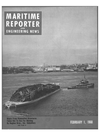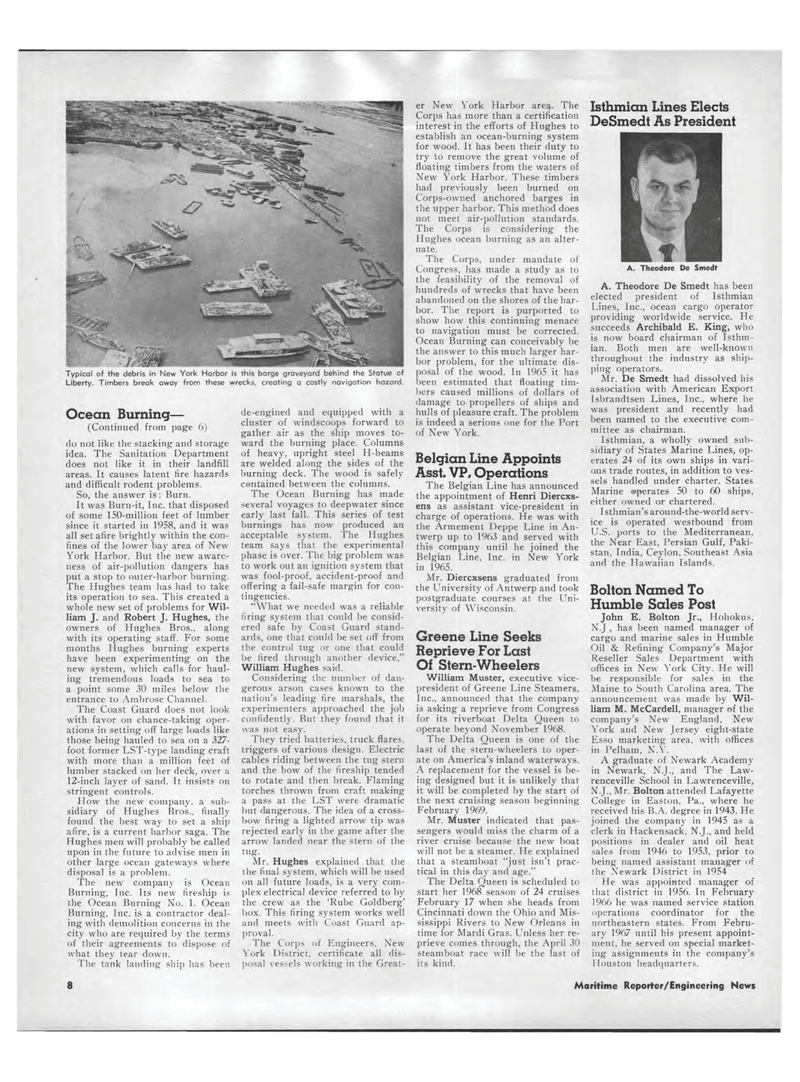
Page 6: of Maritime Reporter Magazine (February 1968)
Read this page in Pdf, Flash or Html5 edition of February 1968 Maritime Reporter Magazine
Typical of the debris in New York Harbor is this barge graveyard behind the Statue of Liberty. Timbers break away from these wrecks, creating a costly navigation hazard. Ocean Burning? (Continued from page 6) do not like the stacking and storage idea. The Sanitation Department does not like it in their landfill areas. It causes latent fire hazards and difficult rodent problems. So, the answer is: Burn. It was Burn-it, Inc. that disposed of some 150-million feet of lumber since it started in 1958, and it was all set afire brightly within the con-fines of the lower bay area of New York Harbor. But the new aware-ness of air-pollution dangers has put a stop to outer-harbor burning. The Hughes team has had to take its operation to sea. This created a whole new set of problems for Wil-liam J. and Robert J. Hughes, the owners of Hughes Bros., along with its operating staff. For some months Hughes burning experts have been experimenting on the new system, which calls for haul-ing tremendous loads to sea to a point some 30 miles below the entrance to Ambrose Channel. The Coast Guard does not look with favor on chance-taking oper-ations in setting off large loads like those being hauled to sea on a 327-foot former LST-type landing craft with more than a million feet of lumber stacked on her deck, over a 12-inch layer of sand. It insists on stringent controls. How the new company, a sub-sidiary of Hughes Bros., finally found the best way to set a ship afire, is a current harbor saga. The Hughes men will probably be called upon in the future to advise men in other large ocean gateways where disposal is a problem. The new company is Ocean Burning, Inc. Its new fireship is the Ocean Burning No. 1. Ocean Burning, Inc. is a contractor deal-ing with demolition concerns in the city who are required by the terms of their agreements to dispose of what they tear down. The tank landing ship has been de-engined and equipped with a cluster of windscoops forward to gather air as the ship moves to-ward the burning place. Columns of heavy, upright steel H-beams are welded along the sides of the burning deck. The wood is safely contained between the columns. The Ocean Burning has made several voyages to deepwater since early last fall. This series of test burnings has now produced an acceptable system. The Hughes team says that the experimental phase is over. The big problem was to work out an ignition system that was fool-proof, accident-proof and offering a fail-safe margin for con-tingencies. "What we needed was a reliable firing system that could be consid-ered safe by Coast Guard stand-ards, one that could be set off from the control tug or one that could be fired through another device." William Hughes said. Considering the number of dan-gerous arson cases known to the nation's leading fire marshals, the experimenters approached the job confidently. But they found that it was not easy. They tried batteries, truck flares, triggers of various design. Electric cables riding between the tug stern and the bow of the fireship tended to rotate and then break. Flaming torches thrown from craft making a pass at the LST were dramatic but dangerous. The idea of a cross-bow firing a lighted arrow tip was rejected early in the game after the arrow landed near the stern of the tug. Mr. Hughes explained that the the final system, which will be used on all future loads, is a very com-plex electrical device referred to by the crew as the 'Rube Goldberg' box. This firing system works well and meets with Coast Guard ap-proval. The Corps of Engineers, New York District, certificate all dis-posal vessels working in the Great-er New York Harbor are^. The Corps has more than a certification interest in the efforts of Hughes to establish an ocean-burning system for wood. It has been their duty to try to remove the great volume of floating timbers from the waters of New York Harbor. These timbers had previously been burned on Corps-owned anchored barges in the upper harbor. This method does not meet air-pollution standards. The Corps is considering the Hughes ocean burning as an alter-nate. The Corps, under mandate of Congress, has made a study as to the feasibility of the removal of hundreds of wrecks that have been abandoned on the shores of the har-bor. The report is purported to show how this continuing menace to navigation must be corrected. Ocean Burning can conceivably be the answer to this much larger har-bor problem, for the ultimate dis-posal of the wood. In 1965 it has been estimated that floating tim-bers caused millions of dollars of damage to propellers of ships and hulls of pleasure craft. The problem is indeed a serious one for the Port of New York. Belgian Line Appoints Asst. VP, Operations The Belgian Line has announced the appointment of Henri Diercxs-ens as assistant vice-president in charge of operations. He was with the Armement Deppe Line in An-twerp up to 1963 and served with this company until he joined the Belgian Line, Inc. in New York in 1965. Mr. Diercxsens graduated from the University of Antwerp and took postgraduate courses at the Uni-versity of Wisconsin. Greene Line Seeks Reprieve For Last Of Stern-Wheelers William Muster, executive vice-president of Greene Line Steamers, Inc., announced that the company is asking a reprieve from Congress for its riverboat Delta Queen to operate beyond November 1968. The Delta Queen is one of the last of the stern-wheelers to oper-ate on America's inland waterways. A replacement for the vessel is be-ing designed but it is unlikely that it will be completed by the start of the next cruising season beginning February 1969. Mr. Muster indicated that pas-sengers would miss the charm of a river cruise because the new boat will not be a steamer. He explained that a steamboat "just isn't prac-tical in this day and age." The Delta Queen is scheduled to start her 1968 season of 24 cruises February 17 when she heads from Cincinnati down the Ohio and Mis-sissippi Rivers to New Orleans in time for Mardi Gras. Unless her re-prieve comes through, the April 30 steamboat race will be the last of its kind. Isthmian Lines Elects DeSmedt As President A. Theodore De Smedt A. Theodore De Smedt has been elected president of Isthmian Lines, Inc., ocean cargo operator providing worldwide service. He succeeds Archibald E. King, who is now board chairman of Isthm-ian. Both men are well-known throughout the industry as ship-ping operators. Mr. De Smedt had dissolved his association with American Export Isbrandtsen Lines, Inc., where he was president and recently had been named to the executive com-mittee as chairman. Isthmian, a wholly owned sub-sidiary of States Marine Lines, op-erates 24 of its own ships in vari-ous trade routes, in addition to ves-sels handled under charter. States Marine operates 50 to 60 ships, either owned or chartered. Isthmian's around-the-world serv-ice is operated westbound from U.S. ports to the Mediterranean, the Near East, Persian Gulf, Paki-stan, India, Ceylon, Southeast Asia and the Hawaiian Islands. Bolton Named To Humble Sales Post John E. Bolton Jr., Hohokus, N.J , has been named manager of cargo and marine sales in Humble Oil & Refining Company's Major Reseller Sales Department with offices in New York City. He will be responsible for sales in the Maine to South Carolina area. The announcement was made by Wil-liam M. McCardell, manager of the company's New England, New-York and New Jersey eight-state Esso marketing area, with offices in Pelham, N.Y. A graduate of Newark Academy in Newark, N.J., and The Law-renceville School in Lawrenceville, N.J., Mr. Bolton attended Lafayette College in Easton, Pa., where he received his B.A. degree in 1943. He joined the company in 1945 as a clerk in Hackensack, N.J., and held positions in dealer and oil heat sales from 1946 to 1953, prior to being named assistant manager of the Newark District in 1954 He was appointed manager of that district in 1956. In February 1966 he was named service station operations coordinator for the northeastern states. From Febru-ary 1967 until his present appoint-ment, he served on special market-ing assignments in the company's Houston headquarters. 8 Maritime Reporter/Engineering News

 5
5

 7
7
